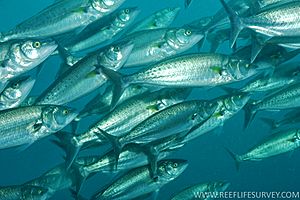Western Australian salmon facts for kids
Quick facts for kids Western Australian salmon |
|
|---|---|
 |
|
| Scientific classification | |
| Synonyms | |
|
The Arripis truttacea, also known as the Western Australian salmon, is a type of fish found in the ocean. It belongs to a group of fish called ray-finned fish. This fish is special because it is only found in the waters off southern Australia. It's the only species in its group, called Arripis, which is part of the family Arripidae.
Contents
What Does It Look Like?
The Western Australian salmon has a smooth, long body that is a bit flat. Its tail section is narrow, and its head is fairly small. The eyes are small, and older fish have a clear, jelly-like patch around them.
Its mouth is medium-sized and points upwards a little. The jaw reaches below the center of its eyes. It has small, sharp teeth in both jaws. The fish's body is covered in small scales, which makes it feel smooth, especially on larger fish. A line along its side, called the lateral line, is almost straight.
It has a long fin on its back, called the dorsal fin. This fin has a small dip in the middle, separating the spiny part from the soft part. The spiny part is taller. It also has a small fin on its underside, called the anal fin, which is about half the length of the soft dorsal fin. Its tail is deeply forked, like a "V" shape.
Adult salmon are grey-green or blue on their backs. They often have yellow or dark grey spots. Their undersides are shiny white. The fins near their gills, called pectoral fins, are pale yellow. Other fins are see-through. Young salmon look similar but have more spots and dark edges on their fins.
The dorsal fin has 9 spines and 15 to 19 soft rays. The anal fin has 3 spines and 9 or 10 soft rays. These fish can grow up to 96 centimetres (38 in) long, but they are usually around 65 centimetres (26 in). The heaviest recorded fish weighed 10.5 kilograms (23 lb). One way to tell this fish apart from a similar species, Arripis trutta, is by counting their gill rakers. The Western Australian salmon has 25-31 gill rakers, while A. trutta has 33-40.
Where Does It Live?
The Western Australian salmon lives only in the coastal waters of southern Australia. You can find it from Lakes Entrance in Victoria all the way to Kalbarri in Western Australia. However, it's not very common north of Lancelin in Western Australia.
Life in the Ocean
Adult Western Australian salmon swim in large groups, called schools. They gather near open beaches and rocky reefs. Young salmon, called juveniles, use shallow bays and estuaries as safe places to grow up. You can often find these young fish in beds of Posidonia seagrass and in creeks with Avicennia mangrove trees. Adult schools can also be found in estuaries and deeper waters offshore.
These fish are carnivores, meaning they eat other animals. They mostly hunt small, schooling fish, often called baitfish. In turn, the Western Australian salmon is hunted by seals, dolphins, and sharks.
Reproduction and Life Cycle
Western Australian salmon travel to southwestern Australia to spawn (lay eggs) starting in March. They mainly gather between Cape Leeuwin and Busselton in late autumn and early winter. This timing matches when the eastward-flowing Leeuwin Current is strongest. This current, along with easterly winds, helps carry the newly hatched baby fish, called larvae, southeast.
These larvae settle along the entire southern coast of Australia. Most of them are carried to the waters off Victoria and Tasmania. They grow up in these "nursery grounds" between South Australia and Tasmania for three to four years. After this, they migrate west back to Western Australia. They form schools near Hopetoun and Esperance. Once they finish spawning in mid-winter, the adults return to the southeastern Western Australian waters.
Fishing for Salmon
The Western Australian salmon is an important fish for commercial fishing along the south coast of Western Australia. Fishermen using large nets from beaches, called beach seiners, have been catching them since 1940. This fishery is managed by special groups that give out licenses to commercial fishermen. In 2019, 24 licenses were given out. The amount of fish caught is considered to be sustainable, meaning there are enough fish left for the future.
This salmon is also popular with people who fish for fun. It's known as a strong fighter. People usually catch them from rocky shores or beaches, but also from boats. There are rules about how many fish you can catch (bag limits), and you need a license to catch them from powered boats.
The meat of the Western Australian salmon has a strong taste. It can be a bit oily, rough, and soft. Because of this, it's not highly valued as a fresh food fish. Most of the fish caught by commercial fishermen are sent to be canned.
Its Name and Family
The Western Australian salmon was first officially described in 1829 by George Cuvier. He named it Centropristis truttaceus. It was later moved to the genus Arripis. Even though it's called "salmon," it's not related to the true salmon fish, which belong to the family Salmonidae. The Western Australian salmon is one of four species in the genus Arripis. This group of fish, called Arripidae, is found only in Australia and New Zealand.
People also call this fish by many other names, such as bay trout, blackback, buck salmon, cockie salmon, colonial salmon, jack salmon, jacky, kahawais, lumpy, ocean trout, poundies, salmon trout, Southern Australian salmon, and trout.

